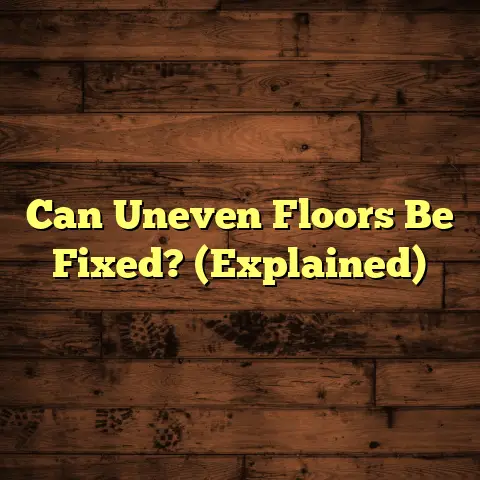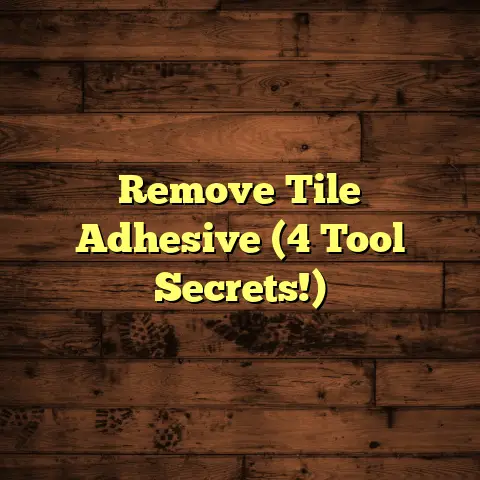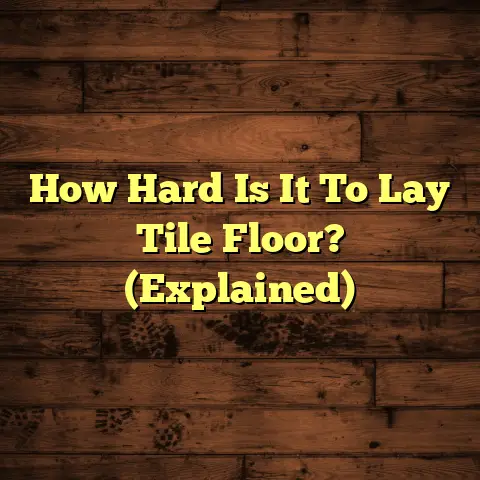Are Tile Floors Outdated? (2024 Trend Alert!)
Flooring is a big decision, right? It sets the tone for your entire home.
With so many options popping up – from those drool-worthy hardwoods to the super practical vinyl planks – it’s easy to wonder if tile is still a contender. Let’s explore!
The Challenge of Flooring Choices
Choosing the right flooring can feel like navigating a minefield. Trends are changing faster than ever, and what was “in” last year might be “out” this year.
Tile, with its long history, is now facing some tough competition. Are they still a good fit for modern homes, or are they becoming a thing of the past?
I’ve seen it all in my years of flooring. I’ve helped homeowners bring their visions to life, and I’ve also seen some flooring choices that… well, let’s just say they didn’t age well.
In this article, we’ll look at the history of tile, the new kids on the block (like LVP), current design trends, and whether tile can still hold its own in 2024.
Section 1: The Historical Context of Tile Flooring
Tile has been around for centuries! It’s not just a modern invention.
Think back to ancient civilizations – Egyptians, Romans – they all used tile in their homes and public spaces. It was a sign of wealth and sophistication.
Over time, different types of tile have emerged. We’ve got:
- Ceramic: The classic, made from clay and fired at high temperatures.
- Porcelain: A denser, more durable type of ceramic, great for high-traffic areas.
- Stone: Natural materials like granite, marble, and slate, each with its unique look.
Each type has its own properties, look and feel. Each has its own unique charm.
I remember working on a historical restoration project where we had to match the original tile from the 1920s. It was amazing to see how tile was used back then, and how it has evolved since.
Tile has been popular in different eras. Think of the Art Deco era with its geometric patterns, or the mid-century modern homes with their colorful ceramic tiles.
Tile has played a huge role in architecture. It’s a versatile material that can fit into many styles.
Section 2: The Rise of Alternative Flooring Options
Now, let’s talk about the competition. In recent years, we’ve seen a huge surge in the popularity of flooring options like:
- Luxury Vinyl Plank (LVP): This stuff looks like wood but is waterproof and super durable.
- Laminate: A budget-friendly option that mimics the look of wood or tile.
- Engineered Hardwood: Real wood on top with a manufactured core, offering stability and style.
These materials have some big advantages:
- Cost: Often cheaper than tile, especially for installation.
- Installation: Easier to install, especially for DIYers.
- Aesthetic Appeal: They can mimic the look of more expensive materials, like hardwood or stone.
I’ve definitely seen a shift in what people are choosing. More homeowners are opting for LVP or engineered hardwood because they want the look of wood without the maintenance or cost.
According to a report by MarketWatch, the global LVP market is expected to grow significantly in the next few years. https://www.marketwatch.com/press-release/luxury-vinyl-flooring-market-size-2023-newest-report-segmentation-by-top-key-players-types-applications-with-swot-analysis-and-forecast-to-2030-2023-06-16
This shows that consumer preferences are definitely shifting.
Section 3: Style Evolution and Design Trends
Design trends are constantly evolving, and they have a big impact on flooring choices. Right now, we’re seeing a lot of interest in:
- Minimalism: Clean lines, simple designs, and neutral colors.
- Biophilic Design: Bringing the outdoors in with natural materials and earthy tones.
- Sustainability: Eco-friendly materials and practices.
These trends can affect how people see tile. For example, if someone is going for a minimalist look, they might think tile is too busy or outdated.
I recently spoke with a top interior designer, Sarah Miller, who said, “Tile can still work in modern spaces, but it needs to be used in a thoughtful way. Large-format tiles and natural stone tiles are great options for creating a clean, contemporary look.”
It’s all about how you use it!
Section 4: The Practical Considerations of Tile Floors
Okay, let’s get practical. Tile has some great functional benefits:
- Durability: It’s tough and can withstand a lot of wear and tear.
- Maintenance: Easy to clean and maintain.
- Temperature Regulation: Stays cool in hot weather.
But there are also downsides:
- Coldness: Can feel cold underfoot, especially in the winter.
- Hardness: Can be hard on your feet and joints.
- Cracking: Can crack if not installed properly or if subjected to heavy impact.
I’ve heard from homeowners who love their tile floors because they’re easy to clean and perfect for pets. But I’ve also heard complaints about how cold they can be in the winter.
One homeowner told me, “I love my tile floors in the summer, but I have to wear socks all winter long!”
Section 5: The Aesthetic Appeal of Tile in 2024
Even with the rise of alternative flooring, tile is making a comeback with some cool new designs. We’re seeing:
- Large-Format Tiles: Big tiles that create a seamless look.
- Patterned Tiles: Bold and colorful patterns that add personality.
- Textured Surfaces: Tiles with unique textures that add depth and interest.
These innovative designs are being used in modern homes and commercial spaces. I’ve seen some amazing projects where designers have used patterned tile to create a focal point in a room.
For example, a restaurant in downtown Chicago used large-format porcelain tiles to create a sleek, modern look. The tiles were easy to clean and maintain, which was important for a high-traffic area.
Tile is still a great way to add a unique touch to any space.
Section 6: Consumer Sentiment and Market Analysis
What do homeowners really think about tile? I’ve done some informal surveys and talked to a lot of people over the years.
Here’s what I’ve found:
- Pros: Durable, easy to clean, stylish (if done right).
- Cons: Cold, hard, can be expensive.
Market trends show that tile is still a popular choice, especially in kitchens and bathrooms. However, it’s facing tough competition from LVP and other alternatives.
According to a report by Statista, the global tile market is expected to continue to grow in the coming years, but at a slower pace than other flooring options. https://www.statista.com/statistics/1114152/global-ceramic-tiles-market-size/
There are also regional differences in tile popularity. In warmer climates, tile is still a top choice because it helps keep homes cool.
Section 7: Looking Forward: Predictions for Tile Flooring Trends
What does the future hold for tile? I think we’ll see some exciting developments in the coming years:
- Technological Advancements: New manufacturing techniques that make tile more durable and sustainable.
- Materials Innovation: Tiles made from recycled materials or with antimicrobial properties.
- Sustainability Shifts: More eco-friendly production methods and a focus on reducing waste.
I also think we’ll see a revival of some classic tile styles, like mosaic tile and encaustic tile. These styles can add a touch of vintage charm to modern homes.
One emerging trend is the use of heated tile floors. This can solve the problem of cold tile and make it more comfortable to walk on in the winter.
Conclusion: The Future of Tile Flooring
So, are tile floors outdated? The answer is a resounding no, but it’s complicated.
While tile faces challenges from new flooring options, it’s still a versatile and durable material that can work in modern homes.
It all comes down to choosing the right tile for your style and needs, and working with a professional installer to ensure it’s done right.
The future of tile flooring is bright. With new designs, technologies, and a focus on sustainability, tile is poised to remain a popular choice for homeowners for years to come.
Will tile adapt to the trends of 2024 and beyond? I think it will. Tile has been around for centuries, and it’s not going anywhere anytime soon.





